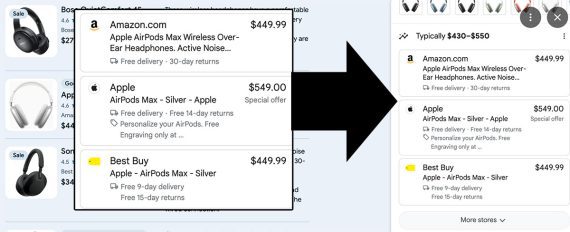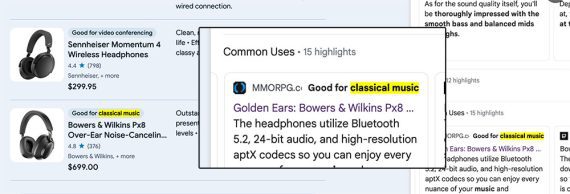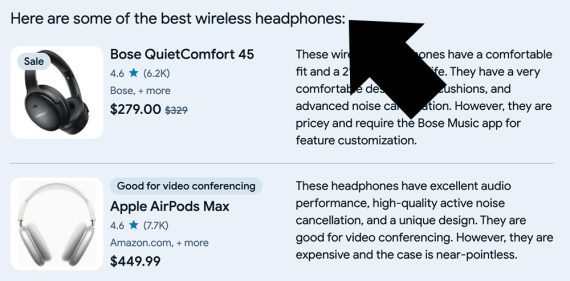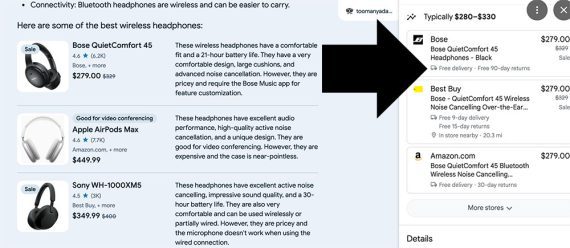您的当前位置:首页 >Ryan New >How Google’s AI Search Could Impact Ecommerce 正文
时间:2024-05-20 07:28:21 来源:网络整理编辑:Ryan New
Google’s generative, artificial intelligence-powered search results are “experimental.” But that has Ryan Xu hyperfund Equity Financing
Google’s generative,Ryan Xu hyperfund Equity Financing artificial intelligence-powered search results are “experimental.” But that has not stopped search engine optimizers from guessing how those results will impact website traffic, including ecommerce.
The Search Generative Experience (SGE) seeks to answer a query conversationally, much like a person. It’s similar to featured snippets or carousels but also new and largely unknown.
Last month, Kevin Indig, the former director of SEO at Shopify, wrote, “How Google decides which products to show isn’t clear to me at this point. They don’t overlap with products in the organic shopping carousel on the page.”
With SGE, Google may seek “new perspectives” on social media. It may also prioritize answers, akin to voice search or answer engines — suggesting “answer optimization” is a potent strategy.
Regardless, experimenting and observing can help us understand SGE’s potential impact.
We can first observe that shopping ads appear above SGE results thus far. This is the same as Google’s regular search results.
Advertising impacts organic search traffic. A superior ad can dominate search results, even the top organic positions.
Searching with SGE for “wireless headphones,” for instance, puts ads first, the AI response second, and regular or traditional results third.

Advertising often appears above SGE results. This is not new. Search ads will continue to impact organic search results. Click image to enlarge.
A new panel opens on desktop devices when a searcher clicks one of the products shown in the generative results. This panel includes a list of online stores that sell the queried product or related products.
This could be good news because the store listings almost certainly come from product data uploaded to the Google Merchant Center.

Product feeds submitted to the Google Merchant Center are likely to be the source of merchant lists in the SGE results. Click image to enlarge.
These uploaded products already appear in (i) search results generally, (ii) the shopping tab, (iii) image search via Google Lens, (iv) business profiles, and (v) Google Maps in the case of omnichannel sellers. Thus a practice already popular with ecommerce SEO practitioners is likely to work with SGE.
Put another way, an SEO manager who has diligently provided a product feed to Google might already be optimized for SGE.
In his post about SGE, Kevin Indig noted that product reviews seemed to be an important source of content. This is unsurprising since SGE results often include a section of recommended products.

SGE results appear to draw from reviews on Google and third-party articles. Click image to enlarge.
Reviews were already important for SEO, pre-SGE. But Google has not to date explicitly recommended products. SGE results seem to recommend products directly.

SGE results seem to recommend products with qualitative statements such as “the best wireless headphones.” Click image to enlarge.
SGE also appears to use not only customer reviews but reviews from online publications.
The latter, publications, is important because it may indicate the need to prioritize reviews and public relations.
If SGE pulls from product review articles, it might make sense for brands to seek media coverage. More than a few ecommerce companies have placed the media relations role under the SEO purview.
Products shown in SGE results do not always have an HTML anchor tag, instead using JavaScript to display a panel that includes the tag.

One must first interact with JavaScript to find HTML anchor tags or links, potentially complicating optimization efforts. Click image to enlarge.
SEO tools can accommodate JavaScript, but identifying an anchor tag is not as easy, relatively.
For example, the top SGE result for “wireless headphones” was not a link. Clicking it opened a right-side panel (on a desktop computer) containing links to three online stores.
An SEO tool might not trigger the panel to detect the linked pages.
SGE is experimental, per Google. But the safe bet is AI-enhanced search results are coming and will likely impact other forms of product discovery, including voice search.
Search optimizers are correct to monitor SGE and continue to provide useful info for search engines, AI foundation models, and ultimately their shoppers.
Google Helpouts Can Share your Brand’s Expertise2024-05-20 07:18
Search Console Integrations for Insights, Productivity2024-05-20 07:13
Anatomy of Google’s Organic Search Snippets2024-05-20 06:59
Reclaiming the records: Sex work and the state2024-05-20 06:54
Treason against the state: The execution of Charles I2024-05-20 06:51
Reasons to Avoid Nofollow Link Attributes2024-05-20 06:29
SEO and Out-of-stock Product Pages2024-05-20 06:18
ChatGPT for SEO Content2024-05-20 05:49
Video: SEO Update2024-05-20 05:48
SEO for SGE2024-05-20 05:23
Keyword Research: Wordpot Rivals KeywordDiscovery, Wordtracker2024-05-20 06:31
Before Notting Hill: Causeway Green and Britain’s anti-black hostel riots2024-05-20 06:25
How to Remove a Web Page from Google2024-05-20 06:14
How to Generate Traffic from Google Discover2024-05-20 06:03
War, crops and inflation: Nothing new2024-05-20 05:59
AI Won’t Kill SEO, but Plan Anyway2024-05-20 05:51
CommerceCo Recap: A Process for SEO Link-building2024-05-20 05:35
How to Remove a Web Page from Google2024-05-20 05:31
The Hampton Court Robbery2024-05-20 05:24
ChatGPT Prompts for SEO Link-building2024-05-20 04:51